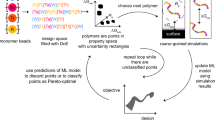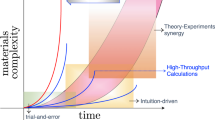Abstract
Machine-learning (ML) approaches have proven to be of great utility in modern materials innovation pipelines. Generally, ML models are trained on predetermined past data and then used to make predictions for new test cases. Active-learning, however, is a paradigm in which ML models can direct the learning process itself through providing dynamic suggestions/queries for the “next-best experiment.” In this work, the authors demonstrate how an active-learning framework can aid in the discovery of polymers possessing high glass transition temperatures (Tg). Starting from an initial small dataset of polymer Tg measurements, the authors use Gaussian process regression in conjunction with an active-learning framework to iteratively add Tg measurements of candidate polymers to the training dataset. The active-learning framework employs one of three decision making strategies (exploitation, exploration, or balanced exploitation/exploration) for selection of the “next-best experiment.” The active-learning workflow terminates once 10 polymers possessing a Tg greater than a certain threshold temperature are selected. The authors statistically benchmark the performance of the aforementioned three strategies (against a random selection approach) with respect to the discovery of high-Tg polymers for this particular demonstrative materials design challenge.





Similar content being viewed by others
References
A. Mannodi-Kanakkithodi, T.D. Huan, and R. Ramprasad: Mining materials design rules from data: the example of polymer dielectrics. Chem. Mater. 29, 9001–9010 (2017).
T.D. Huan, S. Boggs, G. Teyssedre, C. Laurent, M. Cakmak, S. Kumar, and R. Ramprasad: Advanced polymeric dielectrics for high energy density applications. Prog. Mater. Sci. 83, 236–269 (2016).
A. Mannodi-Kanakkithodi, G. Pilania, and R. Ramprasad: Critical assessment of regression-based machine learning methods for polymer dielectrics. Comput. Mater. Sci. 125, 123–135 (2016).
T.D. Huan, A. Mannodi-Kanakkithodi, C. Kim, V. Sharma, G. Pilania, and R. Ramprasad: A polymer dataset for accelerated property prediction and design. Sci. Data 3, 160012 (2016).
A. Mannodi-Kanakkithodi, G. Pilania, R. Ramprasad, T. Lookman, and J.E. Gubernatis: Multi-objective optimization techniques to design the pareto front of organic dielectric polymers. Comput. Mater. Sci. 125, 92–99 (2016).
A. Mannodi-Kanakkithodi, G. Pilania, T.D. Huan, T. Lookman, and R. Ramprasad: Machine learning strategy for accelerated design of polymer dielectrics. Sci. Rep. 6, 20952 (2016).
A. Mannodi-Kanakkithodi, A. Chandrasekaran, C. Kim, T.D. Huan, G. Pilania, V. Botu, and R. Ramprasad: Scoping the polymer genome: a roadmap for rational polymer dielectrics design and beyond. Mater. Today 21, 785–796 (2018).
A. Mannodi-Kanakkithodi, G.M. Treich, T.D. Huan, R. Ma, M. Tefferi, Y. Cao, G.A. Sotzing, and R. Ramprasad: Rational co-design of polymer dielectrics for energy storage. Adv. Mater. 28, 6277–6291 (2016).
V. Sharma, C.C. Wang, R.G. Lorenzini, R. Ma, Q. Zhu, D.W. Sinkovits, G. Pilania, A.R. Oganov, S. Kumar, G.A. Sotzing, S.A. Boggs, and R. Ramprasad: Rational design of all organic polymer dielectrics. Nat. Commun. 5, 4845 (2014).
D. Das, A. Chandrasekaran, S. Venkatram, and R. Ramprasad: Effect of crystallinity on Li adsorption in polyethylene oxide. Chem. Mater. 30, 8804–8810 (2018).
S.P. Ong, O. Andreussi, Y. Wu, N. Marzari, and G. Ceder: Electrochemical windows of room-temperature ionic liquids from molecular dynamics and density functional theory calculations. Chem. Mater. 23, 2979–2986 (2011).
M.K. Warmuth, J. Liao, G. Rätsch, M. Mathieson, S. Putta, and C. Lemmen: Active learning with support vector machines in the drug discovery process. J. Chem. Inf. Comput. Sci. 43, 667–673 (2003). PMID: 12653536.
B. Shahriari, K. Swersky, Z. Wang, R.P. Adams, and N. De Freitas: Taking the human out of the loop: a review of Bayesian optimization. Proc. IEEE 104, 148–175 (2016).
B. Rouet-Leduc, C. Hulbert, K. Barros, T. Lookman, and C.J. Humphreys: Automatized convergence of optoelectronic simulations using active machine learning. Appl. Phys. Lett. 111, 043506 (2017).
R. Yuan, Z. Liu, P.V. Balachandran, D. Xue, Y. Zhou, X. Ding, J. Sun, D. Xue, and T. Lookman: Accelerated discovery of large electrostrains in BaTiO3-based piezo-electrics using active learning. Adv. Mater. 30, 1702884 (2018).
T. Mueller, A.G. Kusne, and R. Ramprasad: Machine learning in materials science: recent progress and emerging applications. In Reviews in Computational Chemistry, edited by A.L. Parrill and K.B. Lipkowitz (John Wiley & Sons, Inc., New York, 29, 2016), pp. 186–273.
R. Ramprasad, R. Batra, G. Pilania, A. Mannodi-Kanakkithodi, and C. Kim: Machine learning in materials informatics: recent applications and prospects. npj Comput. Mater. 3, 54 (2017).
D.J. Audus and J.J. de Pablo: Polymer informatics: opportunities and challenges. ACS Macro Lett. 6, 1078–1082 (2017).
J.S. Peerless, N.J. Milliken, T.J. Oweida, M.D. Manning, and Y.G. Yingling: Adv. Theory Simul. 2, 1800129 (2018).
S. Thrun: Handbook of Brain Science and Neural Networks (MIT Press, Cambridge, 1995), pp. 381–384.
J. Brandup, E.H. Immergut, and E.A. Grulke: Polymer Handbook, 4th ed. (John Wiley and Sons, New York, 1999).
J. Bicerano: Prediction of Polymer Properties (Marcel Dekker, Inc., New York, USA, 2002).
Polymer Properties Database. http://polymerdatabase.com, (accessed April 10, 2019).
B. Rouet-Leduc, K. Barros, T. Lookman, and C.J. Humphreys: Optimization of GaN LEDs and the reduction of efficiency droop using active machine learning. Sci. Rep. 6, 24862 (2016).
L. Bassman, P. Rajak, R.K. Kalia, A. Nakano, F. Sha, J. Sun, D.J. Singh, M. Aykol, P. Huck, K. Persson, and P. Vashishta: Active learning for accelerated design of layered materials. npj Comput. Mater. 4, 74 (2018).
D. Weininger: SMILES, a chemical language and information system. 1. Introduction to methodology and encoding rules. J. Chem. Inf. Model. 28, 31–36 (1988).
C. Kim, A. Chandrasekaran, T.D. Huan, D. Das, and R. Ramprasad: Polymer genome: a data-powered polymer informatics platform for property predictions. J. Phys. Chem. C 122, 17575–17585 (2018).
P. Pankajakshan, S. Sanyal, O.E. de Noord, I. Bhattacharya, A. Bhattacharyya, and U. Waghmare: Machine learning and statistical analysis for materials science: stability and transferability of fingerprint descriptors and chemical insights. Chem. Mater. 29, 4190–4201 (2017).
T.D. Huan, A. Mannodi-Kanakkithodi, and R. Ramprasad: Accelerated materials property predictions and design using motif-based fingerprints. Phys. Rev. B 92, 14106 (2015).
P. Labute: J. Mol. Graph. Model. 18, 464–477 (2000).
P. Ertl, B. Rohde, and P. Selzer: Fast calculation of molecular polar surface area as a sum of fragment-based contributions and its application to the prediction of drug transport properties. J. Med. Chem. 43, 3714–3717 (2000).
S. Prasanna and R. Doerksen: Topological polar surface area: a useful descriptor in 2D-QSAR. Curr. Med. Chem. 16, 21–41 (2009).
K. Nguyen, L. Blum, R. van Deursen, and J-L. Reymond: Classification of organic molecules by molecular quantum numbers. ChemMedChem 4, 1803–1805 (2009).
RDKit: Open Source Toolkit for Cheminformatics. http://www.rdkit.org/ (accessed April 10, 2019).
A. Forrester and A.K.A. Sóbester: Engineering Design via Surrogate Modelling (John Wiley and Sons, Chichester, West Sussex, 2008).
Author information
Authors and Affiliations
Corresponding author
Additional information
Chiho Kim and Anand Chandrasekaran equally contributed to this work.
Rights and permissions
About this article
Cite this article
Kim, C., Chandrasekaran, A., Jha, A. et al. Active-learning and materials design: the example of high glass transition temperature polymers. MRS Communications 9, 860–866 (2019). https://doi.org/10.1557/mrc.2019.78
Received:
Accepted:
Published:
Issue Date:
DOI: https://doi.org/10.1557/mrc.2019.78




